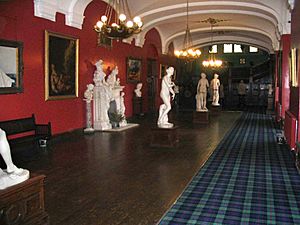Carbisdale Castle facts for kids
Quick facts for kids Carbisdale Castle |
|
|---|---|

Carbisdale Castle
|
|
| Location | Kyle of Sutherland, Scottish Highlands |
| OS grid reference | NH574954 |
| Built | 1905–1917 |
| Built for | Duchess of Sutherland |
| Architect | John Robertson |
| Architectural style(s) | Scots Baronial |
|
Listed Building – Category B
|
|
| Designated | 18 March 1971 |
| Reference no. | LB7165 |
| Lua error in Module:Location_map at line 420: attempt to index field 'wikibase' (a nil value). | |
Carbisdale Castle is a beautiful castle built in 1907. It sits on a hill in the Scottish Highlands, overlooking the Kyle of Sutherland. For many years, until 2011, it was a popular youth hostel where young people could stay.
The castle is designed in the Scots Baronial style, which is a type of Scottish architecture. It's located near Culrain, not far from Bonar Bridge. Today, Carbisdale Castle is a protected building. After closing for repairs in 2011, it was sold in 2016. The new owners plan to turn it into a "world-class private residence."
Contents
The Story of Carbisdale Castle
A Castle Built from a Family Feud
Carbisdale Castle was built between 1905 and 1917 for Mary Caroline, the Duchess of Sutherland. She was the second wife of the 3rd Duke of Sutherland. Their marriage wasn't very popular with the Duke's family.
When the Duke passed away in 1892, his son, Cromartie, disagreed with his father's will. There was a legal dispute about the Duchess's inheritance. Eventually, the Sutherland family and the Duchess reached an agreement. The Duchess received a good amount of money. The family also agreed to build her a castle, but only if it was outside their own lands.
The Duchess chose a spot just outside the Sutherland lands in Ross-shire. She built the castle on a hillside where it could be seen from a large part of Sutherland. This included the main road and railway line that the Sutherland family used. Because of this, the castle became known as the "Castle of Spite." Many believed the Duchess placed it there to annoy her former relatives.
This idea is supported by the castle's tower. It only has clocks on three sides. The side facing Sutherland is blank! People say the Duchess didn't want to give her former family the time of day.
A Safe Place for a King
In 1933, a wealthy Scottish businessman named Colonel Theodore Salvesen bought the castle. During World War II, when Nazi Germany occupied Norway, the castle became a safe haven. Colonel Salvesen offered it as a refuge for King Haakon VII of Norway and his son, Crown Prince Olav (who later became King Olav V).
Important meetings were held at the castle during the war. One famous agreement, made at the Carbisdale Conference in 1941, stated that Russian forces would leave Norway after the war. This agreement was kept when the Red Army entered Norway in 1944.
After Colonel Salvesen passed away, his son, Captain Harold Salvesen, inherited the castle. He generously gave the castle and its contents to the Scottish Youth Hostels Association. Carbisdale Castle Youth Hostel then opened its doors to visitors in June 1945.
New Beginnings for the Castle
In February 2011, the youth hostel closed because of damage from frost. More serious structural problems were found, and over £2 million was spent on repairs.
Towards the end of 2014, the Scottish Youth Hostels Association decided to sell Carbisdale Castle. Many valuable art pieces, including marble sculptures and 19th-century paintings, were sold at an auction. This raised £1 million for the association. The castle was finally sold in September 2016 to FCFM Group Ltd.
Castle Features and Legends
The castle is very large, covering about 41,433 square feet (3,849 square meters). It has 365 windows! As mentioned, the clock-tower only has clocks on three sides.
There used to be a secret door hidden below the Great Staircase. You could open it by turning one of the statues. This special mechanism is no longer in use. Before it closed, the castle had a huge collection of art, with some pieces from as far back as 1680. It also had many beautiful Italian marble statues.
Spooky Stories and Ghosts
Carbisdale Castle is also known for its ghost stories! People say several ghosts live there. Paranormal experts have even investigated the castle.
Some of the reported sightings include a lady in white. There are also stories of fallen soldiers from the Battle of Carbisdale in 1650. Visitors have also heard the sounds of a piper playing.
One of the most famous ghosts is "The Hooded Gardener." He is said to roam the castle grounds, searching for his lost daughter. People say he haunts girls who are around 15 years old, the same age as his daughter. He is reportedly seen dressed in black, with a black hood, and only part of his face showing.


